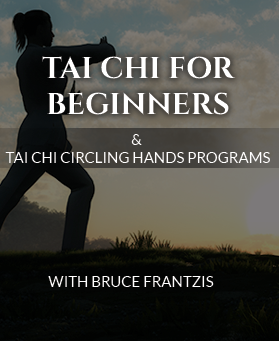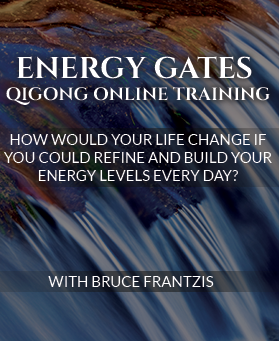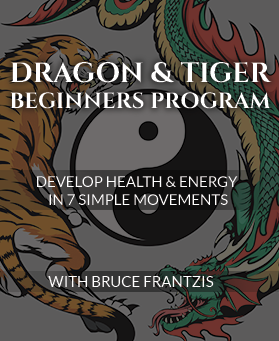Possibilities of an Art Realized
My last teacher in China, Liu Hung Chieh, was a master of bagua, tai chi, hsing-i and Taoist meditation. In addition, he was a master calligrapher and a classical Chinese scholar who had a complete knowledge of traditional Chinese medical theory.
My teacher Liu, by having his mind non-physically contact my body, was able to use the energy in my body to literally move me around the room when I practiced Walking the Circle. He could do this while practicing with me, sitting and meditating, and most powerfully when writing calligraphy, which he did every day. When he wrote, it was like the stories of the classical Taoists, who by writing talismans could cause mystical events to happen.
My teacher Liu’s chi focused through the calligraphy like a lens. He told of how his teacher Ma Shr Ching used to practice with swords or empty hands while Dong Hai Chuan was sitting meditating. With his eyes closed, Dong would correct Ma and tell him what to do. Sometimes, when Liu would move me with his chi, I felt as if a mist were falling on me from the sky, but oddly it felt like a heavy weight. After I felt saturated with the weight of the mist, I would be moved around the room. At other times, it felt as if I was trying to walk through a solid wall of mud. It was incredible.
When I could feel Liu’s energy bubbling inside my system, he did not say anything. His energy would simply start coming through. His method of teaching bagua and other internal martial arts involved some physical corrections and instructions, but he relied primarily on chi transmissions. Since I had so much background in physical movement and martial arts techniques, Liu concentrated on showing me how my internal energy was supposed to move by using and transmitting his own energy into my body/mind. Liu also trained me in the freehand exchanges of bagua fighting techniques and the healing methods of qigong (chi gung) therapy and qigong tui na, a type of bodywork.
Wang Shu Jin, Hung I Hsiang and Liu Hung Chieh all had incredible power. They had the ability to discharge energy (fa jin) to the extent that they could effortlessly and painlessly uproot and send the strongest of students flying for many feet in any direction they chose.They also had the ability to touch you with no apparent force and project their energy inside the body to cause injury or pain, if necessary. Liu had the added ability to heal with the same light fa jin touch.
Of the three men, Liu was the most powerful. This fact is hard to believe since Liu weighed less than 110 pounds, whereas Hung was in the 240-pound range and Wang was closer to 300 pounds. On one of my first days with Liu, he asked about my martial arts background. Liu said that I looked big and strong, which I was at over 200 pounds. As a small test, he got up and put his hand in the Single Palm Change posture and asked me to move it. I could not. Like Wang, Liu said that chi was more important than size, youth or strength.
Liu’s Path as a Youth
Liu came from a wealthy family. He was originally a very studious nonphysical young man who focused on classical Confucian studies. In fact, he graduated from university in Beijing, which was highly unusual in that era for a future martial arts master.
Frail as a youth, he reasoned that if he did not strengthen his body when young, he could easily have health problems later in life. Wanting to be strong like most male youths, and being a fan of the martial art novels of the day, he asked his parents if he could learn martial arts. Liu came from a family that had produced many generations of Chinese doctors. As such, his parents were supportive in Liu strengthening his chi and blood circulation, as well as learning and experiencing his own body the tenets of Chinese medicine.
Liu’s parents also thought that being able to protect oneself against physical violence was useful, especially in politically unstable times. Thus, when Liu was eleven years old, his family granted his wishes. They took him to learn the Six Combination Northern Shaolin external martial art system from a reputable master. Liu’s situation then was similar to most contemporary middle- or upper-class urban-dwelling Americans or Europeans who want to learn martial arts.
Taking to martial arts with great enthusiasm and diligent practice, Liu progressed rapidly, to the point where his teacher felt that he had learned his basics well. His teacher also felt that it was his responsibility to pass the talented Liu on to a higher-level master who could better help Liu fulfill his potential.
Liu’s Shaolin teacher took him to the last intact school of the original Beijing bagua tradition. This was the school of Cheng Ting Hua at Chang Wen Men Wai Hua Shi, which hosted the largest gathering of bagua practitioners in Beijing. Liu was formally initiated into the lineage by Cheng Ting Hua’s son, You Lung. At the age of 14, Liu was the last person admitted to the original bagua school. The next youngest person was 30 years old. Here, not only the students who practiced the Cheng style but also students of all bagua styles came to practice together.
The younger students were taught by the senior students, who may have been 30-40 years older and potentially practicing bagua for decades. As well as learning the Cheng Ting Hua Dragon style, Liu also learned the Yin Fu Willow Leaf Palm style. Every evening for two or three hours in a large training hall, the individual senior students would take a younger student and work with him
intensely in the techniques of walking.
Each student was expected to practice what they had learned the night before by themselves in the morning, which Liu did. After the solo work, Liu would practice two-person fighting exercises, empty handed and with weapons (sword and spear), and sparring. Every night, after his homework was finished, Liu would go to the school. This routine lasted for over two and a-half years, until the school was disbanded.
Liu formally kowtowed to Cheng You Lung and Cheng taught him. Being much younger than everyone else in the school, Liu became the school mascot. He gained insights and practice methods from many of the seniors, and began practicing hsing-i chuan.
This school was a true meeting ground for all the top bagua students of Beijing. After the school disbanded, Liu continued to learn from the people he had met there for another decade. Ju Wen Bao initially taught Liu the bagua meditation techniques.
However, the person whom Liu credited with teaching him the most about bagua both in terms of its meditation work and in the mastery of chi was Ma Gui (Ma Shr Ching). One of the top four students of Dong Hai Chun, Ma took no formal disciples. However, Ma liked Liu and introduced him to the higher-level energy work that Ma had learned from Dong.
Very old at the time and fond of drinking, Ma said it was a pity he had not met Liu when he was younger. Liu always said that although his bagua movements were basically those of the Cheng School, the most critical aspects of his internal chi work came from Ma Gui.
The Golden Age of Martial Arts
My teacher Liu told me that prior to 1928 there was a very strong martial arts community in Beijing, consisting of people who really understood gung fu. He said there were many who played at it and did not “have” gung fu, but that there were about 200 who really had it.
These were the people of legends, each of whom could manifest the potential of their gung fu system. Today, that level of skill can no longer be found concentrated in one geographical location. Much in the manner of the literary and artistic boom in Paris of the 1920s, the era was a Golden Age for martial arts in Beijing.
In 1928, China held its first modern national martial arts tournament. Liu Hung Chieh was the representative of the Beijing school at this tournament. Except for strikes to the groin, eyes and throat, everything was legal. The tournament was especially brutal and had to be called off after a day or two as it was deemed that there would be too much death and maiming.
In fact, there was so much violence that midway in the tournament, the winners were decided by vote. The decision went to the hsing-i school. Although the bagua practitioners were at least as capable of inflicting damage as the hsing-i students, they were not as willing to casually exercise the option of maximum violence simply to win.
Liu won all of his matches, but with one interesting twist. The parents of the young man who was his last opponent pleaded with Liu not to harm or maim their son. This was standard behavior in most matches so as to leave no doubt as to who really won. The parents told Liu that they would suffer greatly if their son was not able to take care of them in their old age.
At that time, Liu was a devoted follower of the Confucian tradition and realized how genuine their request must have been, as the parents lost great face just by begging. As a compassionate act, Liu honored the parent’s request, and after clearly showing sufficient superiority to win the match, he stayed away from the young man rather than fully engage him to produce a definitive ending, as had been his original strategy.
Also, at the tournament was Liu’s friend Wang Lai Sheng. It was primarily because of Liu’s performance in this tournament that he became the head instructor of the Hunan Province Central Government Martial Arts Academy in Changsha from 1932 to 1934. During this period, Wu Jien Chuan’s two sons, Wu Gong I and Wu Gong Zao, were junior instructors under Liu. Wu Jien Chuan and his father, Chuan You, co-founded the Wu style of tai chi chuan.
Although both were not strong enough to physically convince Liu of tai chi’s merit, their long discussions about the tai chi philosophy of softness and yielding kindled Liu’s interest. This connection ultimately led to Liu living and studying in Wu Jien Chuan’s house in Hong Kong and becoming his disciple.
Liu then became interested in Buddhism and its spiritual way of life after meeting the enlightened Tien Tai sect Buddhist master Tan Hsiu Fa Shr, who invited him to come to his monastery and learn from him. Liu rejected the monastic life. His master did not require Liu to become a monk, but simply to learn at his monastery. Again, Liu proved to be particularly talented and Tan Hsiu began to teach him privately.
Buddhism, Taoism and the I Ching
After a relatively short time, Tan Hsiu recognized that Liu had realized the Nature of Emptiness, the major objective of Buddhist Mahayana spiritual practice, which in the West is often called enlightenment. After having realized the spiritual tenets of Tian Tai Buddhism from Tan Hsu Fa Shr, Liu spent 10 years alone in the mountains of Western China, training with several Taoist masters from whom he learned the methods of Taoist internal alchemy.
His initial exposure to Taoism occurred when he was around 10 years old. At New Year’s time, the White Cloud Temple in Beijing was open to the public. It was a magical place to the boy and the thing that stuck most in his mind was a group of adepts who sat unmoving 24 hours a day for over a week.
In Western China, Liu studied with individual Taoist adepts, bypassing the monastic route that he had experienced in Buddhism. Not being a talkative man by nature, Liu focused in his communications with me on the practices more than on his own learning situations from his past.
It was with the Taoist adepts that Liu said he completed his studies about chi and realized the root of the I Ching and its manifestations. After this, Liu shifted his primary work away from the efforts and responsibilities of martial arts to Taoism, which included the totality of bagua. Over the next 37 years in Beijing, Liu worked primarily for the spiritual benefit of humankind, as he had become the head of a Northern Taoist lineage.
While instructing me, there was a constant ebb and flow of subjects through which Liu passed on his Taoist teachings. He said it was fortunate we both shared similar loves—qigong (chi gung), internal martial arts, meditation and internal alchemy. He would have liked to have used the methods of literature and calligraphy, but since my classical Chinese was not up to standard, Liu trained me with direct experiential chi transmissions rather than through a literary intellectual tradition.
The day before he died and many times before that, Liu told me that he had transferred all his knowledge into my consciousness and that practice would cause the seeds to grow into full trees. Being just an ordinary mortal, the seeds are growing slowly in me, and yet Liu still remains a source of never-ending inspiration about the possibilities of spirit.
On the last day that he was alive, Liu taught me the internal aspects of the final bagua palm, as well as the last piece of Wu tai chi’s transformational energy work. It was the most intense energetic work I had ever been through. When I told this to Liu, he said it was even harder on him.
He spent much time that day sharing his knowledge and clearing up loose ends with me. The next day Liu died only an hour before our usual lesson. Three days later, his body was still soft and flexible, a sign that an adept had died. He was cremated and a great sadness filled me for a long time.
The Teaching Style of Liu
My teacher Liu used all the methods of Wang, Hung, Huang and Bai Hua, tying the strands of their teachings together into a coherent whole. He then went into entirely new realms. In martial arts, he favored the large movements of Wang and Bai Hua because they were better for the body’s health and for developing the greatest degree of raw power.
He then took all the internal components of small movements and internally combined them into large movements. Thus, when Liu did a strike, he would change the internal pressures of his blow (with the same degree of precision that Hung and Huang did with small movements and shifts of body mechanics) without his outer form changing at all.
Liu was also able to understand and communicate the whole interconnected overview of qigong (chi gung). This experience for me was different from that obtained from my other teachers, who were adepts at specific areas of qigong (chi gung), but were unable to connect all the various divergent threads of the complete qigong tapestry.
Liu was also extremely skilled at explaining how different martial techniques, when done separately or in various combinations, affected the chi of the body medically. He also knew which chi combinations mixed well, neutrally or to ill effect.
Liu also went into great detail about how the martial techniques of bagua, tai chi and to a lesser extent hsing-i could be applied directly in Taoist meditation to turn them into genuine spiritual practices.
Liu’s Teachings on Morality
Liu was very clear about the spiritual nature of Taoist morality, which shares much in common with, yet is often quite different from normal Chinese martial arts or Judeo-Christian morality. These basic moral values included a directive not to interfere with or manipulate the natural chi or the freedom of another individual or spontaneously arising event unless specifically requested.
Pragmatism and integrity were based on internal awareness and clarity rather than specific outer forms, rules or self-interest imposed by society. You were supposed to do what you said you would and say only what you genuinely intended, and were willing to do.
The Golden Rule was to do to others what you would want or be willing for them to do to you, and not do to others what you would not want or be willing for them to do to you. You were to try your best, within your capacity of clarity and awareness, to balance and bring harmony to whatever life spontaneously brought your way.




0 Comments